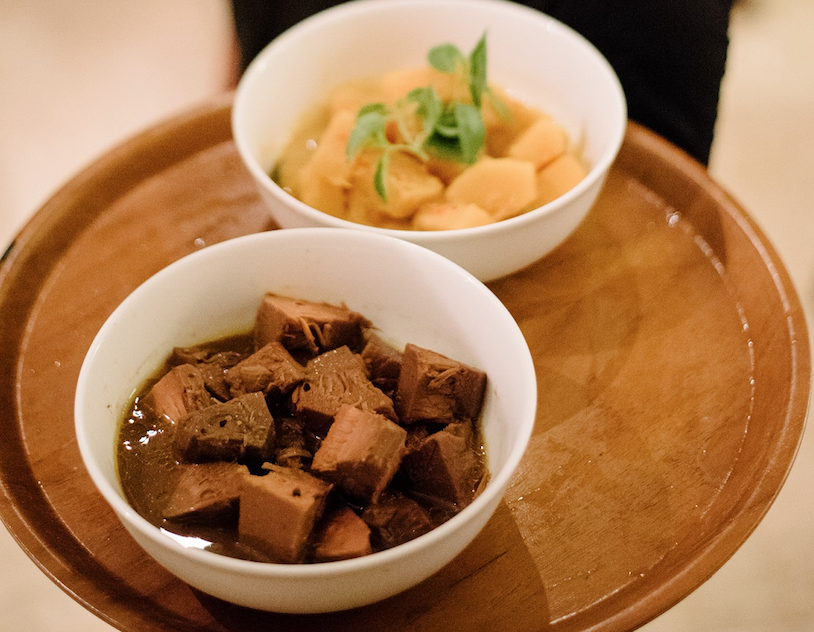 A list of ‘new’ superfoods appears in glossy magazines and food blogs each year, followed by the requisite scientific shakedown by news outlets. One superfood which has recently been attracting more attention from the latter is jackfruit, which is consumed in many regions across the archipelago. Researchers have called it a “miracle crop” while The Guardian has questioned whether it’s “the next big food craze”.
A list of ‘new’ superfoods appears in glossy magazines and food blogs each year, followed by the requisite scientific shakedown by news outlets. One superfood which has recently been attracting more attention from the latter is jackfruit, which is consumed in many regions across the archipelago. Researchers have called it a “miracle crop” while The Guardian has questioned whether it’s “the next big food craze”.
For the second taste of our Indonesian Superfoods series, we sat down to a sumptuous jackfruit curry with UFF Founder & Director Janet DeNeefe to discover more about one of her all-time favorites. (For Janet’s Jackfruit Curry recipe from the pages of her book My Island Home click here.)
What are the nutritional benefits of jackfruit? What makes it a superfood?
Jackfruit is being hailed as a culinary ‘jack of all trades’! It is one of those rare fruits which is rich in the B-complex group of vitamins such as vitamin B-6 (pyridoxine), niacin, riboflavin, and folic acid. It is also rich in dietary fibre, contains Vitamins A and C, and the fresh fruit is a good source of potassium, magnesium, manganese, and iron.
Jackfruit is the new darling of the vegan set, first appearing in California in a faux pulled-pork kind of way, gracing tacos, hamburgers and other modern fare. It truly is a wonderful meat substitute and while it doesn’t contain B12 certainly shines with a ton of other nutritional benefits. It will continue to become more popular, once the western world masters a way of growing and cooking it.
Ibu Janet, why do you love jackfruit so much?
I adore Jackfruit. It’s one of my all-time fav Indonesian foods which doubles as a fruit, when ripe, and a vegetable, when green. In our household we mainly eat it when it’s unripe. Whether it be Balinese-style simmered in the classic combination of piquant spices, mellow sweet Javanese-style or coconut-creamy Padang-style, I love it any way.
My first memory of eating jackfruit was in 1985 when my sister-in-law prepared it, among other dishes, for my farewell party in Ubud. I was totally blown away by the flavor and texture because I thought I was eating tender pork, or maybe beef and then, lo and behold, was told it was a vegetable. I have had a love affair with jackfruit ever since.
How is jackfruit used in Bali?
Here Jackfruit is one of the stars of the Galungan menu. It is prepared on Penampahan Galungan, the day before the main event, and eaten over the next day or two or until it’s finished. We also prepare it for Kuningan. Jackfruit is popular for these types of occasions because it actually tastes better the next day, as the flavor intensifies and the flesh becomes more tender. It also doesn’t spoil. I am not sure if it has a sacred significance – I think it is more about its long-lasting quality, meat like texture and flavor and its sheer grandiose size (it can feed a Balinese family for a couple of days and is in fact the world’s biggest fruit). Jackfruit is also a regular on the Nyepi menu for obvious reasons.
As the world’s biggest fruit, is it difficult to cultivate and prepare?
Slicing it can be tricky as it exudes a sticky latex glue so wearing rubber gloves is necessary, as well as having oil on hand for cleaning the knife. Cultivating jackfruit is easy as it requires very little attention – plant the tree and the fruit simply grows. The only requirement is a tropical or sub-tropical climate. The ripened fruit is delicious, in its buttercup-yellow glory, and curiously reminds me of Hubba-Bubba bubble gum. I especially love it chopped up and stirred through black rice pudding or served with es campur. In Asian supermarkets, you can buy very good quality canned ripe jackfruit if fresh is not available.